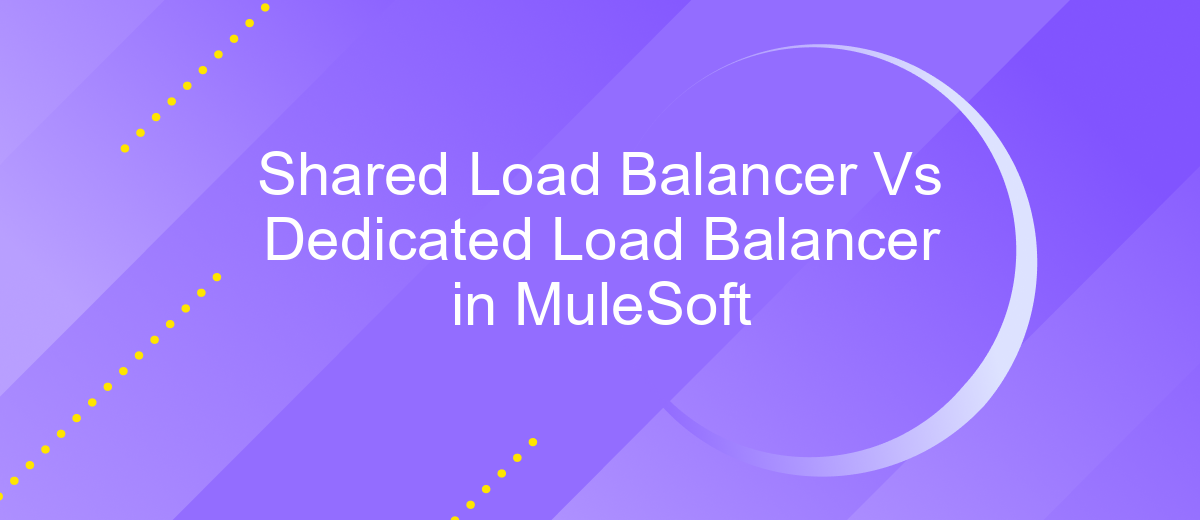Shared Load Balancer Vs Dedicated Load Balancer in MuleSoft
In the world of MuleSoft, choosing the right load balancing strategy is crucial for optimal performance and resource management. This article delves into the key differences between Shared Load Balancers and Dedicated Load Balancers, helping you understand their unique advantages and limitations. By the end, you'll be equipped to make an informed decision tailored to your specific integration needs.
Introduction
In the realm of MuleSoft, load balancing is a critical aspect that ensures optimal performance and reliability of applications. When it comes to choosing between a shared load balancer and a dedicated load balancer, understanding the differences is crucial for making an informed decision. Each option comes with its own set of advantages and potential drawbacks, impacting scalability, cost, and control.
- Shared Load Balancer: Cost-effective, suitable for smaller applications, and managed by the service provider.
- Dedicated Load Balancer: Higher cost, greater control, and tailored to meet specific application needs.
Choosing the right type of load balancer can significantly affect your application's performance and reliability. For businesses looking to streamline their integration processes, tools like ApiX-Drive can offer seamless integration solutions, making it easier to manage and optimize load balancing strategies. Whether you opt for a shared or dedicated load balancer, understanding your specific requirements and constraints will guide you to the best choice for your MuleSoft environment.
Shared Load Balancer

Shared Load Balancer (SLB) in MuleSoft is a cost-effective solution designed to distribute incoming network traffic across multiple servers or applications. By leveraging SLB, organizations can ensure high availability and reliability of their services without the need for dedicated hardware. SLB is particularly useful for handling variable workloads, as it dynamically adjusts to the traffic demands, thus preventing any single server from becoming a bottleneck. Additionally, it simplifies the management of integrations, making it easier to scale applications and services as needed.
One of the key advantages of using a Shared Load Balancer is its seamless integration with third-party services like ApiX-Drive. ApiX-Drive facilitates the automation of data transfers between different applications, enhancing the overall efficiency of your integration processes. By combining SLB with ApiX-Drive, organizations can achieve optimal performance and reliability, ensuring that their applications remain responsive even during peak traffic periods. This synergy not only reduces operational costs but also minimizes the complexity involved in managing multiple integrations.
Dedicated Load Balancer

A dedicated load balancer is a resource exclusively allocated to a single organization or application, providing enhanced performance and security. Unlike shared load balancers, dedicated ones offer greater control over traffic distribution, ensuring optimal performance for critical applications. This type of load balancer is particularly beneficial for organizations with high traffic volumes or specific security requirements.
- Enhanced security: Dedicated load balancers reduce the risk of data breaches by isolating traffic from other users.
- Improved performance: With dedicated resources, organizations can handle higher traffic loads without degradation in performance.
- Custom configurations: Organizations can tailor the load balancer settings to meet their specific needs, optimizing the overall system performance.
For those looking to streamline their integration processes, services like ApiX-Drive can be invaluable. ApiX-Drive offers a range of tools to automate and manage integrations, ensuring that your dedicated load balancer operates seamlessly with other applications. By using such services, organizations can enhance their operational efficiency and maintain robust, high-performing systems.
Comparison

When deciding between a shared load balancer and a dedicated load balancer in MuleSoft, it’s essential to understand the specific needs of your integration environment. Shared load balancers are cost-effective and suitable for smaller applications or environments where traffic is predictable and manageable. They offer a shared infrastructure that can handle multiple tenants, making them an economical choice for many businesses.
On the other hand, dedicated load balancers provide isolated resources dedicated to a single tenant, ensuring higher performance, security, and reliability. This is particularly important for large-scale applications or environments with high traffic and stringent security requirements. Dedicated load balancers can be customized to meet specific needs, offering greater control over traffic management and resource allocation.
- Cost: Shared load balancers are more economical, while dedicated load balancers are more expensive but offer better performance.
- Performance: Dedicated load balancers provide superior performance due to isolated resources.
- Security: Dedicated load balancers offer enhanced security features compared to shared ones.
- Scalability: Dedicated load balancers are more scalable and can handle higher traffic loads.
For businesses looking to streamline their integration processes, services like ApiX-Drive can be beneficial. ApiX-Drive offers seamless integration solutions that can work in conjunction with both shared and dedicated load balancers, ensuring efficient data flow and system performance. By leveraging such services, businesses can optimize their integration strategies and achieve better operational efficiency.
Use Cases
Shared load balancers in MuleSoft are ideal for organizations with smaller scale applications or those in the early stages of development. They provide a cost-effective solution by distributing traffic across multiple instances, ensuring high availability and reliability. This setup is particularly beneficial for businesses that require flexible scaling and do not yet need the dedicated resources of a private load balancer. For instance, companies using integration services like ApiX-Drive, which facilitate seamless data transfer between various applications, can leverage shared load balancers to maintain efficient operations without incurring high costs.
On the other hand, dedicated load balancers are suited for larger enterprises or applications with high traffic volumes and specific performance requirements. They offer enhanced security, customization, and control over traffic management, making them ideal for mission-critical applications. Businesses that need to ensure optimal performance and reliability, such as those running complex integrations via platforms like MuleSoft, will benefit from the dedicated resources provided by dedicated load balancers. This setup guarantees that their integrations, including those managed through services like ApiX-Drive, run smoothly and securely, meeting stringent business requirements.


FAQ
What is the primary difference between a Shared Load Balancer and a Dedicated Load Balancer in MuleSoft?
When should I choose a Dedicated Load Balancer over a Shared Load Balancer?
Can I switch from a Shared Load Balancer to a Dedicated Load Balancer in MuleSoft?
How does a Shared Load Balancer affect the performance of my MuleSoft applications?
Are there any additional costs associated with using a Dedicated Load Balancer in MuleSoft?
Time is the most valuable resource in today's business realities. By eliminating the routine from work processes, you will get more opportunities to implement the most daring plans and ideas. Choose – you can continue to waste time, money and nerves on inefficient solutions, or you can use ApiX-Drive, automating work processes and achieving results with minimal investment of money, effort and human resources.

